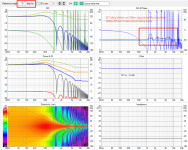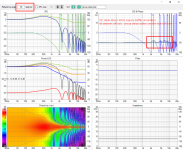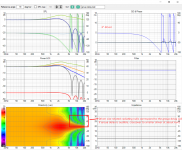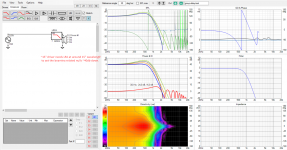I'm merely pointing towards the principle of sound moving across uneven surfaces. Apparently it's beneficial at more than low frequencies. It's the same problem with pneumatics and fluids. They make all kinds of noise and sometimes cavitation, when forced to move across or through narrow spaces. So everywhere, where we need precise sound reproduction, it will be best to "respect" the way sound at a given frequency/wavelength, works in accordance to it's surroundings. My current midrange cabinet, is also a beveled and odd shaped(seen from the midrange) - which sounds like maybe the best speaker I ever had 
Last edited:
Another thread has discussion about group delay. I noticed in the VituixCad simulations that driver size related nulls (beaming) have group delay spikes. If the group delay is audible one should definitely crossover to smaller driver before the driver beams. Baffle size / roundovers didn't change the group delay much, frequency stays the same so it is about the driver size. The nulls get lower in frequency with increasing off-axis angle.
Direct radiating tweeter beams so these effects will show up at least in very high frequencies but might appear around crossover as well if the woofer is crossed over too high. Waveguides don't have these? I can't say if any of this is audible, just an observation about off axis anomaly that is not due to baffle diffraction.
The attachments are
1. 15" driver 70 degrees off axis, 3ms GD spike at 1,5kHz
2. same but 30 degrees off axis, smaller spike and higher in frequency
3. 3" driver 70 degrees off axis, GD spikes only 1ms
Direct radiating tweeter beams so these effects will show up at least in very high frequencies but might appear around crossover as well if the woofer is crossed over too high. Waveguides don't have these? I can't say if any of this is audible, just an observation about off axis anomaly that is not due to baffle diffraction.
The attachments are
1. 15" driver 70 degrees off axis, 3ms GD spike at 1,5kHz
2. same but 30 degrees off axis, smaller spike and higher in frequency
3. 3" driver 70 degrees off axis, GD spikes only 1ms
Attachments
Last edited:
Thanks, this is really interesting. So would you suppose that having a 3 way speaker would lead to a better (wider) polar response than a 2 way? (For the same given bass/mid driver size) and so on. If so, how does a full range driver perform in this respect? (Many though have multiple 'cones' & 'wizzers' or such, maybe in an attempt to overcome these and other issues.
I think someone ( Tmuikku!!) starts with a false premise
The higher the frequency you go, the more it beams.
This happens in nature
So what it's the purpose in music reproduction?!
It's well quite the opposite ( semantics!)Direct radiating tweeter beams so these effects will show up at least in very high frequencies
The higher the frequency you go, the more it beams.
This happens in nature
So what it's the purpose in music reproduction?!
Hopefully we agree that there is a huge difference between music production and sound reproduction?I think someone ( Tmuikku!!) starts with a false premise
It's well quite the opposite ( semantics!)
The higher the frequency you go, the more it beams.
This happens in nature
So what it's the purpose in music reproduction?!
Music is whatever it is. whether a violin beams or not. This a challenge in recordings and mixing in the studio.
Reproduction has to be controlled to closely mimic the experience you would have, while hearing the music live. But recording and listening can never be the same. So we have to control dispersion/directivity, to gain the best compromise - in sound reproduction.
Picowallspeaker: The beaming is related to the transducer size. 1" tweeter beams shorter than 1" wavelengths. Actually the omni nature is lost already at about 1/4 driver diameter to WL ratio. So we are talking about the same thing, high frequencies beam. Maybe my wording was a bit confusing.
jotom750: to "avoid beaming" one could use 5mm diameter fullrange driver to get omni to about 20kHz. But that wouldn't have much low frequency output which require lot of displacement. It is all about physical size of sound (wavelength) and requirement to produce it that kind of demands multiway speaker even with ideal drivers. Real world drivers have electromechanical reality limiting useful range, another reason for multiway speaker. Anyway, to achieve full range sound without (excessive) beaming you need at least two ways. If beaming is kept consistent around crossover on a two way there is a compromise on either low or high frequency capability so a 3 way speaker seems kind of minimum in this regard. Quite a lot of people enjoy 2 way or 1 way speakers so. But if 20-20kHz range is target with any kind of SPL and "sound quality" in mind a 3 way system minimum. I'm happy with about 40 - 14kHz response so 2 way might be enough. Fullrange drivers try to overcome beaming various ways but they have pretty wild polar response, if you manage to find measurements somewhere Lot of people enjoy fullrange speakers as well.
Lot of people enjoy fullrange speakers as well.
By sound quality I mean smooth in room frequency response without distracting issues at comfortably loud SPL, so it depends what one regards distracting and what is comfortably loud Louder is always perceived as better.
Louder is always perceived as better.
jotom750: to "avoid beaming" one could use 5mm diameter fullrange driver to get omni to about 20kHz. But that wouldn't have much low frequency output which require lot of displacement. It is all about physical size of sound (wavelength) and requirement to produce it that kind of demands multiway speaker even with ideal drivers. Real world drivers have electromechanical reality limiting useful range, another reason for multiway speaker. Anyway, to achieve full range sound without (excessive) beaming you need at least two ways. If beaming is kept consistent around crossover on a two way there is a compromise on either low or high frequency capability so a 3 way speaker seems kind of minimum in this regard. Quite a lot of people enjoy 2 way or 1 way speakers so. But if 20-20kHz range is target with any kind of SPL and "sound quality" in mind a 3 way system minimum. I'm happy with about 40 - 14kHz response so 2 way might be enough. Fullrange drivers try to overcome beaming various ways but they have pretty wild polar response, if you manage to find measurements somewhere
By sound quality I mean smooth in room frequency response without distracting issues at comfortably loud SPL, so it depends what one regards distracting and what is comfortably loud
Last edited:
I think a lot of it has to do with size/appearance too. Geddes do manage to make an awesome 2 way - but it require a low crossover and optimized waveguide to make it all smooth. After it became more and more evident that almost all drivers breakup at some point, then waveguided tweeters have become increasingly popular - also because we can cross lower and gain both efficiency and smoother transition in the cross-over. Adding 1 or 2 woofers raises spl ones again, since the midrange no longer needs to play bass. And in any normal reflective room.... off-axis performance is key IMO - regardless of what we or others might enjoy. Toole and Erin touches upon this nicely:Picowallspeaker: The beaming is related to the transducer size. 1" tweeter beams shorter than 1" wavelengths. Actually the omni nature is lost at about 1/4 driver diameter to WL ratio. So we are talking about the same thing, high frequencies beam. Maybe my wording was a bit confusing.
jotom750: to "avoid beaming" one could use 5mm diameter fullrange driver to get omni to about 20kHz. But that wouldn't have much low frequency output which require lot of displacement. It is all about physical size of sound and requirement to produce it that kind of demands multiway speaker. To achieve full range sound without (excessive) beaming you need at least two ways. If beaming is kept consistent around crossover on a two way there is a compromise on either low or high frequency capability so year a 3 way speaker seems kind of optimum in this regard. Guite a lot of people enjoy 2 way or 1 way speakers so. But if 20-20kHz range is target 3 way minimum. Fullrange drivers try to overcome beaming various ways but they have pretty wild polar response, if you manage to find measurements somewhereLot of people enjoy fullrange speakers as well.
Chat with Dr. Floyd Toole - YouTube
Well, I remember the OP having a strange approach to audio, so never mind!picowallspeaker said:Ps. Starting with the basic differences between 1-2-3 way speaker at page 67 of a highly technical subject, it seems a little stupid.
Everybody's free, have fun!
Well.... He threw in some ideas and claims too. That is one way to start an interesting journeyWell, I remember the OP having a strange approach to audio, so never mind!
Everybody's free, have fun!
Thoughts and ideas are like a muscle - it needs resistance/exercise to grow stronger... or else it simply fades away

Yeah, I was driven by that feeling too. As Tmuikku said, louder is mostly better!
That is the main trend. But after 20 years something changes, I'll leave 'louder' to the youngsters.
That is the main trend. But after 20 years something changes, I'll leave 'louder' to the youngsters.
Well.... He threw in some ideas and claims too. That is one way to start an interesting journeyI for one is happy that it happens, because if no one tries something crazy, strange or just different, ones in a while.... we usually do not move out of our comfort zone and find something new
Thoughts and ideas are like a muscle - it needs resistance/exercise to grow stronger... or else it simply fades away
Indeed... though with a bit of EQ... some might like them as 2-waysDigitalthor, Geddes has three way system as well, 2-way mains + subs
Getting older her too. Loud can be fun for a short time. But actually I never found loud sounds nice, like from pneumatics, hammering on stuff or the rough sound from a shovel in gravel to the much to often illegal exhaust on these summer-motorcyclist driving down narrow city roads - twisting their throttle-wrist every 300 m or so with the clutch engaged on their middle-aged panic investment. Sorry for my small rant there - but I actually like to hear birds singing and wind in the treesYeah, I was driven by that feeling too. As Tmuikku said, louder is mostly better!
That is the main trend. But after 20 years something changes, I'll leave 'louder' to the youngsters.
But with speakers that have good smooth dispersion and deep well controlled bass - like with multi-sub, I actually still enjoy the dynamics of electronics music like Trentemolle, Massive Attack, Yello and others. It might not get super loud, but it still plays great at lower levels, and I also appreciate the higher level of details too in these types of music. So still the same by heart, just better quality sound, a little lower - and older
Yep, high SPL at low frequencies require large drivers. If it was a two way speaker, the crossover would then be rather low (for example under 1kHz) to not get into beaming related issues and have the SPL in lows. This requires quite exceptional tweeter to cover from < 1kHz to > 14kHz. Or what ever the requirement was. If either SPL or high or low frequency extension can be relaxed a 2 way is enough. Frequency response is kind of the king determining sound quality so it is up to the SPL requirement /limit what is good.
What is high SPL? I don't know. My 5" full range speakers didn't get quite loud enough but 15" three way system gets way louder than needed and is a lot more fun. I have to guess how loud is it but I think it must be above 90db at listening spot that is kind of comfortably loud. Pretty loud, but still attracting to listen and not drive away. Real drums at band rehearsals is way to loud, have to wear ear protection. But no way going back to smaller than 15" bass drivers unless the family decides otherwise.
What is high SPL? I don't know. My 5" full range speakers didn't get quite loud enough but 15" three way system gets way louder than needed and is a lot more fun. I have to guess how loud is it but I think it must be above 90db at listening spot that is kind of comfortably loud. Pretty loud, but still attracting to listen and not drive away. Real drums at band rehearsals is way to loud, have to wear ear protection. But no way going back to smaller than 15" bass drivers unless the family decides otherwise.
Last edited:
- Home
- Loudspeakers
- Multi-Way
- World's Best Midranges - Shocking Results & Conclusions.



